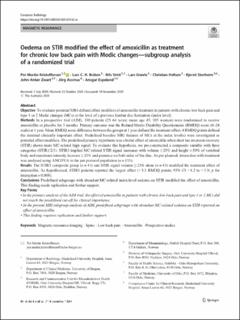| dc.contributor.author | Kristoffersen, Per M | |
| dc.contributor.author | Bråten, Lars Christian Haugli | |
| dc.contributor.author | Vetti, Nils | |
| dc.contributor.author | Grøvle, Lars | |
| dc.contributor.author | Hellum, Christian | |
| dc.contributor.author | Storheim, Kjersti | |
| dc.contributor.author | Zwart, John-Anker | |
| dc.contributor.author | Assmus, Jörg | |
| dc.contributor.author | Espeland, Ansgar | |
| dc.date.accessioned | 2021-05-31T09:14:57Z | |
| dc.date.available | 2021-05-31T09:14:57Z | |
| dc.date.created | 2021-01-18T18:25:34Z | |
| dc.date.issued | 2021 | |
| dc.Published | European Radiology. 2020, . | |
| dc.identifier.issn | 0938-7994 | |
| dc.identifier.uri | https://hdl.handle.net/11250/2757007 | |
| dc.description.abstract | Objective
To evaluate potential MRI-defined effect modifiers of amoxicillin treatment in patients with chronic low back pain and type 1 or 2 Modic changes (MCs) at the level of a previous lumbar disc herniation (index level).
Methods
In a prospective trial (AIM), 180 patients (25–64 years; mean age 45; 105 women) were randomised to receive amoxicillin or placebo for 3 months. Primary outcome was the Roland-Morris Disability Questionnaire (RMDQ) score (0–24 scale) at 1 year. Mean RMDQ score difference between the groups at 1 year defined the treatment effect; 4 RMDQ points defined the minimal clinically important effect. Predefined baseline MRI features of MCs at the index level(s) were investigated as potential effect modifiers. The predefined primary hypothesis was a better effect of amoxicillin when short tau inversion recovery (STIR) shows more MC-related high signal. To evaluate this hypothesis, we pre-constructed a composite variable with three categories (STIR1/2/3). STIR3 implied MC-related STIR signal increases with volume ≥ 25% and height > 50% of vertebral body and maximum intensity increase ≥ 25% and presence on both sides of the disc. As pre-planned, interaction with treatment was analysed using ANCOVA in the per protocol population (n = 155).
Results
The STIR3 composite group (n = 41) and STIR signal volume ≥ 25% alone (n = 45) modified the treatment effect of amoxicillin. As hypothesised, STIR3 patients reported the largest effect (− 5.1 RMDQ points; 95% CI − 8.2 to − 1.9; p for interaction = 0.008).
Conclusions
Predefined subgroups with abundant MC-related index-level oedema on STIR modified the effect of amoxicillin. This finding needs replication and further support.
Key Points
• In the primary analysis of the AIM trial, the effect of amoxicillin in patients with chronic low back pain and type 1 or 2 MCs did not reach the predefined cut-off for clinical importance.
• In the present MRI subgroup analysis of AIM, predefined subgroups with abundant MC-related oedema on STIR reported an effect of amoxicillin.
• This finding requires replication and further support. | en_US |
| dc.language.iso | eng | en_US |
| dc.publisher | Springer | en_US |
| dc.rights | Navngivelse 4.0 Internasjonal | * |
| dc.rights.uri | http://creativecommons.org/licenses/by/4.0/deed.no | * |
| dc.title | Oedema on STIR modified the effect of amoxicillin as treatment for chronic low back pain with Modic changes—subgroup analysis of a randomized trial | en_US |
| dc.type | Journal article | en_US |
| dc.type | Peer reviewed | en_US |
| dc.description.version | publishedVersion | en_US |
| dc.rights.holder | Copyright The Author(s) 2020 | en_US |
| cristin.ispublished | true | |
| cristin.fulltext | original | |
| cristin.qualitycode | 2 | |
| dc.identifier.doi | 10.1007/s00330-020-07542-w | |
| dc.identifier.cristin | 1873652 | |
| dc.source.journal | European Radiology | en_US |
| dc.source.pagenumber | 4285-4297 | en_US |
| dc.identifier.citation | European Radiology. 2021, 31, 4285-4297. | en_US |
| dc.source.volume | 31 | en_US |

